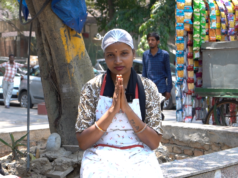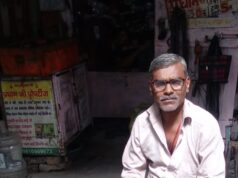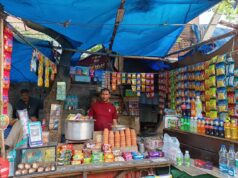Press-wallah: Mahavir and Sita
The husband-wife team of Mahavir and Sita who are street vendors work in an ‘istri’ (ironing) stall in an upper-middle-class neighbourhood, East Delhi. They migrated from a village in Basti district in Uttar Pradesh. Sita attended primary school and did not recall the reason why she stopped going to school one day. All she remembers about school is combing her hair in braids, tying them up in a single loop with red ribbons every morning and wearing a crumpled uniform. Mahavir attended school until ninth grade and dropped out after being bullied for being too thin and physically weak.“The boys would taunt and call me ‘
Mahavir’s father and uncles had inherited a small sugarcane farm in the village. Selling their land to a wealthy, local farmer, his uncles and cousins moved to Delhi seeking better prospects. After marriage, Mahavir and Sita moved to Delhi to work in his cousins’ garment business in the city’s busy Sadar Bazaar. Mahavir’s day was spent unloading, unpacking, and
Life has not changed much for them since then. Their day starts with sweeping the area, padding the two wooden tables with a few folded, thick cotton sheets to get a two-inch insulation. While Mahavirprepares the iron, cautiously feeding charcoal to a few already red pieces and blowing air to make sure the heat spreads evenly; Sita does her morning rounds collecting clothes from her regulars. She waits patiently at their doorstep while they bundle the clothes in old cloth. Most residents count the clothes; a few do not. As far as Sita can remember, she has not misplaced or lost a single garment. The client’s old cloth not only secures the clothes, making it easy for her to carry, but also works as a name tag. She knows that the clothes tied in the faded yellow saree with a green border belong to apartment 65, those in the old blue and grey bedsheet are from apartment 37. On most mornings, she does a minimum of eight pickups. More bundles trickle in during the day. Then there are those few, urgent requests, “Jaldi,
For hours on their feet, the duo work alongside in silence with matched precision and speed – their shoulders hunched over the soon-to-be tamed garment on their table. As the left hand flattens the wrinkles, the right takes control of the 5 kg hot iron, moving it up and down the fabric to remove every unwanted crease until it is all smooth. Periodically, they sprinkle water on the garment, which provokes the angry iron to hiss as it vanquishes the last of the stubborn wrinkles. A garment can take anywhere between 4and10 minutes. They are open all seven days a week from 10 am to late evening
Over the years, more buildings have come up in the neighbourhood. With more residents, both competition and earnings have increased. Mahavir estimates that the two ‘istri-stands’ in the early days have increased to 18. Collectively, they provide services to 30 residential buildings. To ensure that competition stays fair and more ‘press-wallahs’ do not enter their territory, the 18 have agreed to cater to residents only in the buildings assigned to them through an informal agreement. That means Sita can collect clothes only from ‘Greenview Apartments’ and the left wing of ‘Shobhana Building’. Moreover, talks with the RWAs have paid off. Now, outside‘press-wallahs’ cannot enter the premises. This arrangement has secured both: Sita’s turf and the buildings from entry and exit of multiple vendors. With a low chance of poaching, rates for ironing clothes are similar across the18 vendors. However, as with everything else, these have increased over time. Twenty-five years ago, Mahavir recollects that they charged 50 paise for children’s and ladies’ clothes, 75 paise for men’s clothes and ₹2 for sarees. Now the rates are higher and less discriminatory: ₹5 for all garments except ₹15 for saree and ₹10 for bedsheets.
Mahavir estimates they do an average of 90 pieces a day in the summer, 100 during monsoons, and 70 in the winter season. He plainly explained how seasons and his business are intertwined, “In summer, people wear cotton clothes that need to be washed and ironed daily. In winter, people wear
I ask them whether local authorities harass them or not. “Policemen used to come more often earlier asking for ‘
Mahavir and Sita have three children. Sandhya, 23 and Usha, 21 are unmarried, college-educated girls and Anil, their son is 16 and in high school. Sandhya is a librarian in a private school while Usha stays at home to cook and clean for the family. Occasionally, Usha does rebel and questions why she has to be the family’s housekeeper.
Mahavir educated his daughters despite his limited resources. He had hoped that a good education would help the girls find good husbands with stable jobs. “The problem is that a ‘good husband’ and his parents want a dowry of ₹10 lacs. Where will I get that kind of money for two marriages?” he laments. The parents acknowledge that their financial situation has improved since Sandhya started earning; yet sometimes
I remind him that the residents endearingly refer to them as Sita-Ram (Hindu Gods). Isn’t that a reflection of their respect for their reliable ‘press-wallah’? He smiled shyly and said, “I am a ‘chhota
Mahavirand Sita’smonthly income-expenditure account:
| Expenditure | Amount (₹) | Income | Amount (₹) |
| Coal (75kg@₹30/kg)1 | 2,250 | Revenue from Ironing@₹500 per day | 15,000 |
| Food, gas | 4,500 | Sandhya’s salary5 | 8,000 |
| Electricity, water, cable TV | 500 | Rent received6 | 2,500 |
| Miscellaneous (clothes, toiletries, medicines, etc.) | 2,500 | Interest on fixed deposit at BoB4@6.6% | 1,100 |
| Anil’s school-related expenses2 (fees, books, uniform) | 2,800 | ||
| Fee for Anil’s mobile repair course2 | 1,250 | ||
| Mobile phone bill (four prepaid plans)3 | 400 | ||
| Savings4 | 12,400 | ||
| Total | 26,600 | 26,600 |
1In the summer, Mahavir and Sita buy a bag of 5 kg of coal for ₹150 that lasts two days. The amount bought in monsoon and winter varies depending on the ‘dryness’ of coal. In winter, the price of coal can vary from ₹150 to ₹175 for a 5 kg bag.
2Anil attends an English medium private school. He has enrolled in an evening certificate course in mobile repair. On a monthly basis, the course fee is ₹1,250.
3The family has four prepaid plans. Mahavir and Sita share a phone as they are “always together”; the adult-children have their own phone.
4Savings are deposited with Bank of Baroda. They have ₹2 lacs in fixed deposits. In 2016, they invested in gold for the first time and bought jewelry worth ₹25,000, and in 2017
5It is Sandhya’s first job since graduating from college. She has been working for two years. She takes the metro(public rail transport) to work. Her monthly pass is paid for by the employer. Mahavir and Sita walk to work. Anil rides a bicycle to school.
6In 2007, the couple bought a two-room flat in a redeveloped slum for ₹4.5 lacs. Their family of five share a room and the other room has been rented out to a family of four members. They financed the purchase with personal savings of ₹2.5 lacs, interest-free loans of ₹1.5 lacs from a cousin and ₹50,000 from residents of the buildings, Greenview and Shobhana. Both loans have been paid back.
*Some names and identifying details have been changed to protect the privacy of individuals.
Post Disclaimer
The opinions expressed in this essay are those of the authors. They do not purport to reflect the opinions or views of CCS.






